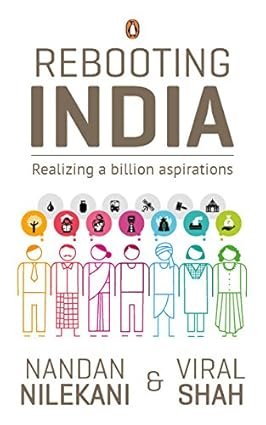1. Introduction

Rebooting India: Realizing a Billion Aspirations is a groundbreaking book by Nandan Nilekani and Viral Shah. Nilekani is the co-founder of Infosys and former chairman of UIDAI, while Shah co-created the Julia programming language. The book falls under non-fiction and political science. Moreover, it explores how technology can transform governance in India. The book focuses on Aadhaar and other technological innovations designed to address governance challenges. The authors suggest technology-driven reforms to improve efficiency, transparency, and inclusivity in India’s public sector. They highlight how these changes could benefit the nation. Consequently, they aim to ensure India fully utilizes its vast demographic dividend.
Nandan Nilekani is renowned for his visionary work in technology and governance. From co-founding Infosys to spearheading the Aadhaar project, his credentials are impeccable. Viral Shah is an equally accomplished technocrat with a robust background in programming and digital governance. Together, they present a fascinating roadmap for India’s future, leveraging their unique expertise in technology and governance to offer innovative solutions.
Reader Engagement: What do you think is the most critical challenge India faces today, and how can technology help? Share your thoughts in the comments below!
2. Why Should You Read This?
“Rebooting India” is not just a book about Aadhaar or technology; it’s a visionary blueprint for transforming India’s governance. At its core, it answers the burning question: how can India, with its vast population and complex socio-political landscape, overcome structural inefficiencies through tech-based solutions? This book is particularly relevant today as we continue to see how digital transformation is changing governance across the globe. For anyone interested in technology, governance, or the future of India, this book provides insights into the inner workings of ambitious projects like Aadhaar and beyond.
In today’s world, where governance challenges abound, Rebooting India provides unique insights into leveraging technology for social transformation. Moreover, its relevance goes well beyond India’s borders. In an era when technology serves as both a challenge and a solution, the book contributes meaningfully to global discussions on digitization and public policy. Furthermore, it offers a comparative analysis, highlighting how India’s approach to using technology for public benefit differs from other global economies.
3. Key Teachings and Themes
The core theme of “Rebooting India” revolves around the idea that technology, if used appropriately, can serve as a great equalizer. Key teachings include:
– Bridging Socio-Economic Divides: Aadhaar as a tool for inclusivity, enabling millions of Indians, especially those on the margins, to access social welfare schemes.
– Efficiency in Governance: How technology can drastically reduce inefficiencies, both financially and administratively, through automation and digitization.
– Technological Transformation: A holistic approach to reforming different sectors—ranging from education, health, and taxation to justice, energy, and public infrastructure—using digital platforms.
Memorable Quotes:
– “Technology is not just an enabler; it is a driver of change, of both mindset and action.”
– “Aadhaar wasn’t just about identity; it was about empowerment for a billion people.”
– “We must ensure that the benefits of digital governance reach the last person in the queue, not just those at the front.”
These quotes encapsulate the transformative power of technology as envisioned by the authors, demonstrating their commitment to leveraging innovation for the common good.
4. How This Book Can Help You
If you are someone intrigued by how technology can solve large-scale societal problems, “Rebooting India” will inspire and inform you. On a practical level, it offers insights into how technology has already begun to change sectors like education, healthcare, and public distribution. For entrepreneurs, policymakers, or anyone working in the realm of social impact, the book serves as a guide to understanding the potential of digital innovation.
Reading this book will change your mindset on governance. It challenges traditional views on how bureaucracy operates and demonstrates how technology can not only simplify government processes but also make them more transparent and accountable. It pushes readers to think about their role in the future of governance and inspires action.
5. Writing Style and Structure
Nandan Nilekani and Viral Shah use a clear, concise writing style that makes complex topics like governance and technology accessible to a general audience. The book is peppered with case studies and real-world examples that illustrate the feasibility of their proposed reforms. The structure is methodical, with each chapter focusing on a different aspect of India’s governance, making it easy to follow.
Despite dealing with technical topics, the book never feels overwhelming. The authors use graphics and charts to break down information, making the arguments more digestible. The flow of the narrative is seamless, moving from problem identification to solution-based thinking, ensuring that readers are always engaged.
6. Criticism of the Book
While “Rebooting India” offers great insights, it isn’t without its flaws. A significant critique is that the book tends to glorify Aadhaar while glossing over its controversies, such as privacy concerns and the exclusion of marginalized groups. The authors, especially Nilekani, often self-reference their achievements, which can come across as self-aggrandizing.
Moreover, while the book is visionary, some might find it overly optimistic. Not every proposed solution may be applicable in a country as diverse and complex as India. There is also little discussion on the potential downsides of digitization, such as data breaches or the misuse of technology.
7. Why Summary Is Not Enough
A summary can only give you a surface-level understanding of what “Rebooting India” offers. To truly appreciate the breadth of ideas and the depth of research, readers need to experience the full text. The nuances of how technology can transform governance are best understood in the context of the detailed explanations and case studies provided by the authors.
8. Thought-Provoking Debates
The book’s optimism about the role of technology in governance sparks several thought-provoking questions. Can technology alone solve deep-rooted governance issues, or does it require a parallel political reform? What about the risks associated with surveillance and data security, especially in a country with weak digital privacy laws? These debates are essential for readers to reflect on as they engage with the book’s content.
9. Who Should Buy or Read This?
“Rebooting India” is ideal for anyone interested in governance, technology, and public policy. It is particularly relevant for:
– Policymakers and government officials looking to reform administrative processes.
– Tech entrepreneurs interested in social impact.
– Academics and students of political science, public administration, or digital governance.
– Individuals working in the development sector.
– Readers curious about the intersection of technology and governance.
As a gift, this book would be perfect for tech enthusiasts, policymakers, and anyone passionate about India’s development.
10. Reasons Not to Buy/Read
– You Already Read Similar Content Elsewhere: If you’ve read other books on digital governance or Aadhaar, this might feel redundant.
– Lack of Interest in the Topic: If you’re not interested in governance or technology, this book may not appeal to you.
– Not a Priority: If technology and governance reforms in India are not on your radar, you might not find it compelling.
11. Conclusion
“Rebooting India” is a bold and ambitious book that outlines a roadmap for transforming India’s governance through technology. While the authors’ enthusiasm sometimes leads to an over-simplification of complex issues, their overall message is compelling. By bridging the gap between policy and technology, Nilekani and Shah present a future where efficient, inclusive governance is possible.
12. Final Recommendation
This book is highly recommended for anyone keen on understanding how technology can play a pivotal role in governance reform. Whether you are a policymaker, a student, or just someone interested in the future of India, “Rebooting India” offers insights that are both practical and visionary. While it has its flaws, the book’s relevance and importance cannot be understated.
How vigyanmayjivan.com Recommends This Product
If you’ve reached this review here awareandbeware.com from our partner site vigyanmayjivan.com, thank you for delving deeper into the evaluation of Rebooting India (PB): Realizing a Billion Aspirations. On vigyanmayjivan.com, we explore how innovations in science and technology can enhance daily life and empower individuals. The book Rebooting India was recommended on our partner site as a resource for those looking to take confident steps toward understanding the changing dynamics of India’s future. The book emphasizes how a strong belief in oneself can help in navigating and utilizing new opportunities, much like the technological advancements we discuss. By exploring the aspirations of a billion people, the book shows how the right mindset and knowledge can lead to meaningful change.
Here on awareandbeware.com, we provide a more detailed look at how this book can be an essential read for anyone interested in India’s evolving landscape. If you haven’t yet visited the blog (new technology; why and how we must learn) on vigyanmayjivan.com, I encourage you to explore it for valuable insights into the thoughtful application of science and technology in everyday life.

